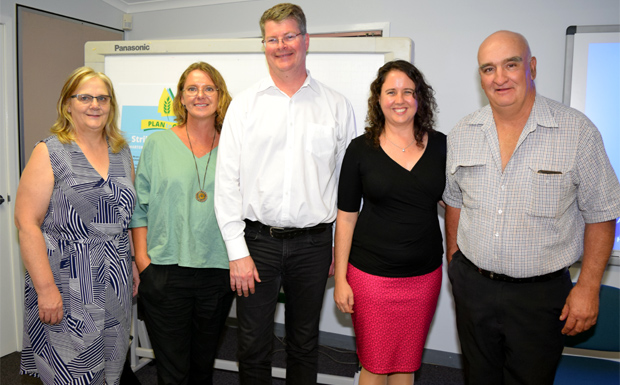
October 19, 2019
The future of coal-fired power stations and the thermal coal mines that feed them looks bleak, guests at a Kingaroy workshop heard on Wednesday night.
Tim Buckley, the South Asia/Australia Director Of Energy Finance Studies at the Institute for Energy Economics and Financial Analysis (IEEFA), said that contrary to what some people think – Queensland’s coal mines would not be seriously affected.
The reason was that four-fifths of Queensland’s coal is coking coal used for steel-making, while most thermal coal comes from NSW and Victoria.
All the same, if global warming is to be kept at two degrees, it means coal mining around the world will virtually cease by 2050 and that’s why there has been a 70 per cent decline in the development of new coal-fired power stations since 2016.
It was also why more than 112 global banks and financial institutions – including the Commonwealth Bank and Suncorp – have announced they will no longer fund coal-fired power stations and thermal coal mines, or insure mines, coal-fired power plants or coal shipments.
Ignoring this reality and investing heavily in non-renewable energy was the chief reason global corporations like General Electric and Exxon Mobil lost hundreds of billions of shareholder wealth in the past four years, Mr Buckley said.
* * *
Mr Buckley was one of four speakers who were invited to share their insights into the future of energy markets and the consequences of coal-fired power plants shutting down at a public forum organised by the Kingaroy Concerned Citizens Group and Plan To Grow Queensland (formerly “Lock The Gate”).
The meeting was attended by about 50 people and included farmers, retirees, Tarong Power Station workers and others with an interest in what might happen to the South Burnett when the Tarong Power Stations shut down at some point between 2030 and 2040.
Mr Buckley told the audience he had worked as a manager for Citigroup for 20 years.
His job there involved analysing energy markets, and he had transferred to IEEFA because it allowed him to extend his studies further.
What he found was that apart from concerns over global warning driving down demand for coal, an even bigger factor was the rapid uptake of renewable energy.
This year almost 47 per cent of Germany’s energy would come from renewables – a pattern that was also being repeated in several other advanced countries – and he thought this showed how unambitious Australia’s renewable energy targets were.
Mr Buckley said not only was renewable technology getting cheaper by roughly 10 per cent a year. eg. the cost of installing rooftop solar systems but the renewables market was now so large it was putting downward pressure on power prices.
He forecast this would result in Australian prices dropping from $100 per MW/h to around $50-$60 per MW/h in the next five to 10 years which would be a boost for consumers and businesses alike.
* * *
Mr Buckley’s talk was followed by Wendy Farmer, the president of Voices Of The Valley, a community group that formed after the Hazelwood mine fire in 2014.
The group researched a community transition plan and then successfully sought support for it, not long after Hazelwood power station announced it would close with just five months warning in March 2017.
Mrs Farmer told the meeting that within days of the closure’s announcement, the Victorian State Government said it would spend $266 million to help affected communities transition to a post-Hazelwood world through a new Latrobe Valley Authority.
However, it soon became apparent the government had no idea what to do.
Voices Of The Valley responded by creating a Community Plan.
Mrs Farmer said since this happened, the fortunes of Morwell and the Latrobe Valley had turned around significantly, and the future now looked much brighter than it did two years ago.
Her main message was that communities facing future power station closures should develop their own community plans and then ask government to fund them.
She said governments of all types were very bad at creative thinking, and communities had a much better idea about what they needed to prosper.
But if governments were presented with workable, sensible plans they would fund them.
* * *
The evening’s third speaker – Dr Amanda Cahill from The Next Economy – said her work involved helping communities facing economic change build fairer, more resilient and sustainable economies.
Her work had initially focussed on the Third World, but as the renewables market grew in Australia she found demand for her expertise grew strongly here as well.
Dr Cahill said there was growing public uncertainty around power prices and a deepening distrust of both government and power companies, fuelled by contradictory attitudes towards renewables.
This factionalism overlooked the point that transitioning to a renewables economy offered many job opportunities in areas such as construction, transport, waste, land use and manufacturing and processing which focussed on reducing and absorbing carbon emissions.
Dr Graham agreed with the night’s first speaker that the transition to a coal-free future was both inevitable and already under way, with $27.7 billion invested in the construction of large-scale renewable energy projects across Australia by August this year.
These projects were helping fuel new manufacturing industries producing components for the renewables economy, such as batteries and spare parts; new construction materials made from recyclables; and renewed interest in regional food and fibre processing.
Dr Cahill said managing any community’s transition from coal-fired power to renewables was a complex process, but it was also a practical one that could cause very little disruption if it were well-managed.
This was already under way in other parts of the world, and Australia could replicate their success.
In closing, Dr Cahill reinforced Mrs Farmer’s point that a key component of managing transition was for communities to develop their own plans, then seek government help to implement them.
* * *
The final speaker of the night was Vicki Perren, who said she was the Wide Bay Burnett co-ordinator of PlanToGrow.org.au.
This was the latest incarnation of the Lock The Gate Alliance now that the battle against coal seam gas mining in the Wide Bay-Burnett had been largely won.
Ms Perren said Plan To Grow’s focus was to encourage the development of community-driven regional plans for Queensland that would ensure the survival of traditional sustainable industries as well as encourage the creation of new sustainable industries and jobs.
She said Queensland’s existing regional plans were either inadequate or out-dated, and because of this communities were not seizing emerging opportunities or protecting the key assets they will need for the future.
- Related article: Forum Looks At A Future Without Tarong
[UPDATED]























